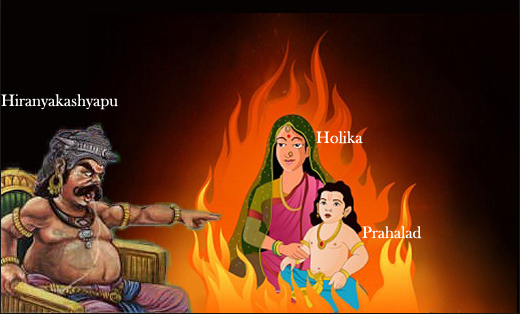Lets think upon Holi...

Holi is considered as one of the most revered and celebrated festivals of India and it is celebrated in almost every part of the country . It is also sometimes called as the “festival of love” as on this day people get to unite together forgetting all resentments and all types of bad feeling towards each other . The great Indian festival lasts for a day and a night , which starts in the evening of Purnima or the Full Moon Day in the month of Falgun . It is celebrated with the name Holika Dahan or Choti Holi on first evening of the festival and the following day is called Holi . In different parts of the country it is known with different names .
The vibrancy of colors is something that brings in a lot of positivity in our lives and Holi being the festival of colours is actually a day worth rejoicing . Holi is a famous Hindu festival that is celebrated in every part of India with utmost joy and enthusiasm . The ritual starts by lighting up the bonfire one day before the day of Holi and this process symbolizes the triumph of good over the bad . On the day of Holi people play with colours with their friends and families and in evening they show love and respect to their close ones with Abeer .
The vibrancy of colors is something that brings in a lot of positivity in our lives and Holi being the festival of colours is actually a day worth rejoicing . Holi is a famous Hindu festival that is celebrated in every part of India with utmost joy and enthusiasm . The ritual starts by lighting up the bonfire one day before the day of Holi and this process symbolizes the triumph of good over the bad . On the day of Holi people play with colours with their friends and families and in evening they show love and respect to their close ones with Abeer .

History of Holi
Holi is an ancient festival of India and was originally known as 'Holika'. The festivals finds a detailed description in early religious works such as Jaimini's Purvamimamsa-Sutras and Kathaka-Grhya-Sutras. Historians also believe that Holi was celebrated by all Aryans but more so in the Eastern part of India.
It is said that Holi existed several centuries before Christ. However, the meaning of the festival is believed to have changed over the years. Earlier it was a special rite performed by married women for the happiness and well-being of their families and the full moon (Raka) was worshiped.
There are two ways of reckoning a lunar month- 'purnimanta' and 'amanta'. In the former, the first day starts after the full moon; and in the latter, after the new moon. Though the amanta reckoning is more common now, the purnimanta was very much in vogue in the earlier days.
According to this purnimanta reckoning, Phalguna purnima was the last day of the year and the new year heralding the Vasanta-ritu (with spring starting from next day). Thus the full moon festival of Holika gradually became a festival of merrymaking, announcing the commencement of the spring season. This perhaps explains the other names of this festival - Vasanta-Mahotsava and Kama-Mahotsava.
Besides having a detailed description in the Vedas and Puranas such as Narad Purana and Bhavishya Purana, the festival of Holi finds a mention in Jaimini Mimansa. A stone incription belonging to 300 BC found at Ramgarh in the province of Vindhya has mention of Holikotsav on it. King Harsha, too has mentioned about holikotsav in his work Ratnavali that was written during the 7th century.
The famous Muslim tourist - Ulbaruni too has mentioned about holikotsav in his historical memories. Other Muslim writers of that period have mentioned, that holikotsav were not only celebrated by the Hindus but also by the Muslims.

In some parts of India, specially in Bengal and Orissa, Holi Purnima is also celebrated as the birthday of Shri Chaitanya Mahaprabhu (A.D. 1486-1533). However, the literal meaning of the word 'Holi' is 'burning'. There are various legends to explain the meaning of this word, most prominent of all is the legend associated with demon king Hiranyakashyap.
Hiranyakashyap wanted everybody in his kingdom to worship only him but to his great disappointment, his son, Prahlad became an ardent devotee of Lord Naarayana. Hiaranyakashyap commanded his sister, Holika to enter a blazing fire with Prahlad in her lap. Holika had a boon whereby she could enter fire without any damage on herself. However, she was not aware that the boon worked only when she enters the fire alone. As a result she paid a price for her sinister desires, while Prahlad was saved by the grace of the god for his extreme devotion. The festival, therefore, celebrates the victory of good over evil and also the triumph of devotion.
Legend of Lord Krishna is also associated with play with colors as the Lord started the tradition of play with colours by applying colour on his beloved Radha and other gopis. Gradually, the play gained popularity with the people and became a tradition.
There are also a few other legends associated with the festival - like the legend of Shiva and Kaamadeva and those of Ogress Dhundhi and Pootana. All depict triumph of good over evil - lending a philosophy to the festival.
I have made your job easy to know more about Holi . I have found a site where you can get everything about the festival of colours!! https://www.holifestival.org
Holika Dahan Celebration is the first day of the popular Hindu festival of colours called Holi. Know right muhurat of Holika Dahan time 2020.
ReplyDeletehttps://www.mpanchang.com/festivals/holika-dahan/
Learn all about Holi here
ReplyDelete